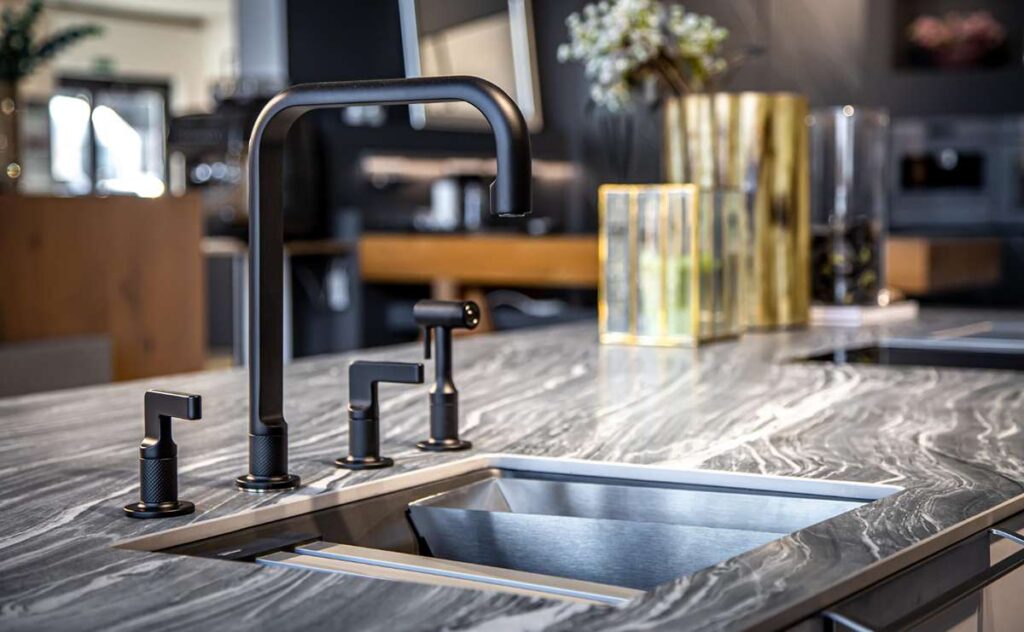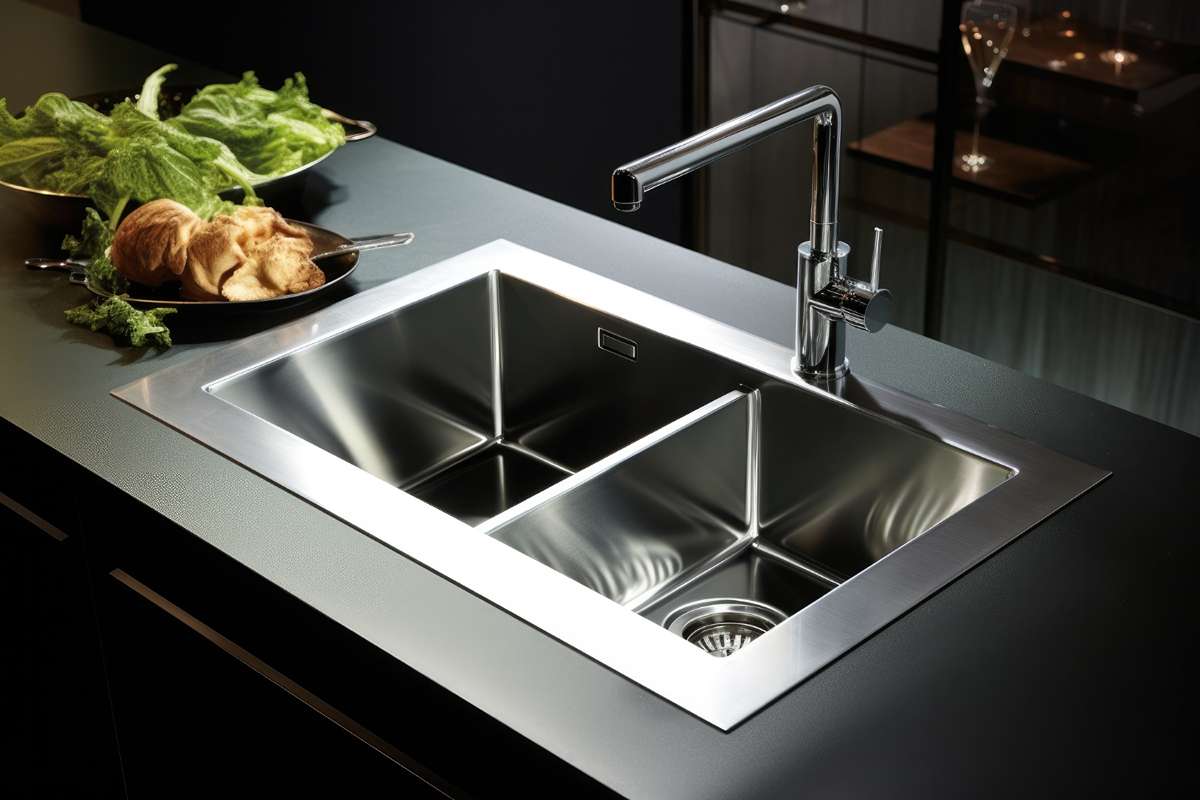If you’re planning a kitchen upgrade, choosing the right sink is a big deal. One popular option you’ll come across is the drawn sink. But what exactly is it? A drawn sink is made using a machine that presses stainless steel into a smooth, bowl-shaped sink — all in one seamless motion. This method makes the sink strong, affordable, and stylish. Understanding how a drawn sink is made and how it performs can help you make a smarter choice. In this guide, we’ll explain everything in simple words, so even a 5th grader can understand. Let’s dive in!
What Is a Drawn Sink?
A drawn sink is a type of stainless steel sink that is made using a special machine. The machine presses a flat sheet of steel into a sink shape — just like pushing dough into a mold. This is called the machine-pressed sink method.
This process gives the sink a deep bowl, smooth corners, and a seamless look. That means there are no joints or sharp edges, making it super easy to clean.You’ll often find drawn sinks in many modern kitchen sink designs because they’re affordable, long-lasting, and look neat in almost any kitchen. They’re also great for busy families who need something strong and simple.
How Is a Drawn Sink Made?
A drawn sink is made using a process called deep drawing. In this method, a flat piece of stainless steel is placed into a machine. The machine then pushes the steel into a sink shape using high pressure.
This process bends the metal smoothly, which is why drawn sinks have round corners and smooth curves. There are no sharp edges or welded seams — just one clean, seamless design. Because it’s made from drawn sink stainless steel, the sink is strong, rust-free, and easy to clean. It also keeps its shine for a long time.
Here’s a quick look at how it all comes together:
| Feature | Description |
| Material | Stainless Steel |
| Method | Machine Drawing (Deep Drawing) |
| Appearance | Smooth Curves, Seamless Finish |
| Thickness | Usually 0.6mm–0.8mm |
Drawn Sink vs Handmade Sink
When choosing the right kitchen sink, it’s helpful to understand the difference between a drawn sink and a handmade sink. Both have their benefits, but they’re made in different ways and suit different kitchen styles and budgets.
What Is a Handmade Sink?
A handmade sink is crafted by skilled workers who shape and weld pieces of stainless steel by hand. Unlike machine-made sinks, these have:
- Straight, clean edges
- Thicker steel, usually above 1mm
- A boxy look, which some people prefer in modern kitchens
Key Differences
Here’s a simple comparison to help you see how drawn sinks and handmade sinks are different:
- Manufacturing Method
- Drawn Sink: Made by machines using deep drawing
- Handmade Sink: Crafted by hand with welding and polishing
- Drawn Sink: Made by machines using deep drawing
- Price
- Drawn Sink: More budget-friendly
- Handmade Sink: Higher price due to labor and material
- Drawn Sink: More budget-friendly
- Appearance
- Drawn Sink: Smooth curves and rounded corners
- Handmade Sink: Sharp edges and a boxy, designer look
- Drawn Sink: Smooth curves and rounded corners
- Durability
- Drawn Sink: Durable enough for everyday use
- Handmade Sink: Often more durable with thicker steel
- Drawn Sink: Durable enough for everyday use
Quick Summary:
- Drawn Sink: Smooth, rounded corners, affordable
- Handmade Sink: Sharp edges, thicker material, higher cost
Best Uses of Drawn Sinks in Modern Kitchens
A drawn sink is a smart choice for many modern kitchens, especially if you’re looking for something that’s affordable, simple, and easy to maintain.
Here’s why people love using drawn sinks in everyday kitchens:
- Perfect for Budget-Friendly Setups
If you’re building or renovating a kitchen without spending too much, a drawn sink is a great fit. It gives you good quality without a high price. - Easy to Clean
The smooth, curved corners of a drawn sink mean there are no sharp edges where dirt can hide. This makes it super easy to wipe and keep clean. - Great for Daily Use
Whether you’re washing vegetables, dishes, or big pots, drawn sinks handle daily tasks without any trouble. They’re built for practical home use. - Fits Small and Medium Kitchens
Drawn sinks come in many sizes, but they’re especially perfect for small or medium kitchens where space is important. They don’t take up too much room, but they still give you enough space to work.
Pros and Cons of Drawn Sinks
Before you decide to buy a drawn sink, it’s good to know both the benefits and a few downsides. This will help you choose the right kitchen sink for your needs.
Advantages of Drawn Sinks
- Affordable
One of the biggest pros is the price. Drawn sinks are budget-friendly and perfect for homeowners who want quality without breaking the bank. - Lightweight
Made with thinner stainless steel, these sinks are lighter in weight. That makes them easier to handle and install. - Easy Installation
Because of their shape and lightweight body, installing a drawn sink is usually quick and simple. - Smooth Finish (No Welding Lines)
Drawn sinks are made using a deep drawing machine, which forms the bowl in one piece. This means no joints or welding lines—just a clean, smooth look.
Disadvantages of Drawn Sinks
- Thinner Material
The steel is often 0.6mm–0.8mm thick, which is fine for most homes, but not as strong as heavier handmade sinks. - Less Noise Reduction
Since the material is thin, these sinks may be noisier when water hits the surface or dishes are dropped in. - May Dent if Hit Hard
A heavy pot or pan dropped suddenly might cause a dent in the sink due to the thinness of the material.
Choosing the Right Drawn Sink for Your Kitchen

Picking the perfect drawn sink can make your kitchen work easier and smoother. But with so many options out there, how do you choose the right one? Let’s break it down in simple steps.
What to Look For
Before buying, keep these key things in mind:
- Size and Depth
Choose a size that fits your counter space. A deeper bowl is great for washing big pots and pans. - Number of Bowls (Single or Double)
- Single-bowl sinks are great for small kitchens or if you want more space in one spot.
- Double-bowl sinks help separate washing and rinsing, which is great for multitasking.
- Single-bowl sinks are great for small kitchens or if you want more space in one spot.
- Stainless Steel Grade
Always go for 304-grade stainless steel. It’s rust-resistant, durable, and perfect for kitchens.
Extra Features to Consider
Some modern drawn sinks come with helpful add-ons that improve functionality:
- Sound-Proof Coating
This layer helps reduce noise when water hits the sink—no more loud clangs. - Anti-Condensation Layer
Keeps moisture from forming under the sink, which protects your cabinets from damage. - Drain Location (Center or Rear)
- Center drains are common and easy to install.
- Rear drains give you more space inside the cabinet for storage or plumbing.
- Center drains are common and easy to install.
Tips to Maintain a Drawn Sink
Keeping your drawn sink clean and shiny is super easy if you follow a few simple steps. These tips will help your sink last longer and look like new every day.
- Clean Daily with a Soft Sponge
After each use, rinse the sink and wipe it down with a soft sponge and mild dish soap. This keeps water spots and stains away. - Avoid Using Steel Wool
Never scrub your sink with steel wool or harsh scrubbers. These can scratch the surface and damage the smooth finish of your stainless steel sink. - Don’t Leave Metal Pans Inside Overnight
Leaving wet pots or pans in the sink can cause rust marks or stains over time. Always empty and dry your sink before bedtime. - Use a Sink Grid to Prevent Scratches
A sink grid protects the bottom of your sink from scratches caused by dishes or utensils. It also improves drainage and airflow.
Why People Choose Drawn Sink Over Others
Many homeowners today prefer a drawn sink for their kitchens, and it’s easy to see why. Whether you’re updating your home or setting up a rental, a drawn sink is often the smart choice.
Cost-Effective
Drawn sinks are budget-friendly, making them perfect for anyone who wants quality without spending too much. They’re usually more affordable than handmade sinks.
Sleek Look
Thanks to the machine-pressed design, drawn sinks have a smooth, seamless finish with gentle curves. This gives your kitchen a modern and clean appearance.
Easy Replacement
Drawn sinks come in standard sizes and shapes, so replacing them later is hassle-free. No need for custom fitting or major plumbing work.
Perfect for Rentals and First-Time Buyers
If you’re setting up a rental home or buying your first kitchen sink, a drawn sink is a smart pick. It’s reliable, easy to maintain, and doesn’t break the bank.
Expert Tips for Choosing and Using a Drawn Sink
When it comes to choosing the right drawn sink, advice from experienced kitchen fitters and plumbers can make all the difference. Here are real tips based on what professionals suggest:
Advice from Kitchen Fitters & Plumbers
- Go for Grade 304 Stainless Steel: It’s more durable and rust-resistant—ideal for long-term kitchen use.
- Check Cabinet Size Before Buying: Always measure your kitchen cabinet space before choosing the sink size to avoid fitting issues.
- Choose Rear Drain Placement: This gives you more space under the sink for storage or garbage disposal units.
Use-Cases from Real Installations
- In compact apartments, single-bowl drawn sinks are preferred because they save counter space.
- In rental units, drawn sinks are chosen for being low-maintenance and cost-effective.
- Busy families love the smooth corners—they’re easy to clean and prevent food build-up.
Trusted Sources for More Guidance
For more inspiration and tips, you can check out expert guides from:
- This Old House
- HGTV Kitchen Upgrades
Sound Insulation Matters
Many drawn sinks come with sound-deadening pads or undercoating, which reduces noise when washing dishes. It’s a helpful feature, especially in open kitchens.
Environmentally Friendly Choice
The deep drawing process uses less raw material and produces minimal waste compared to handmade sinks. This makes it a greener option for eco-conscious homeowners.
Warranty = Peace of Mind
Some top brands offer 5–10 year warranties on drawn sinks. Always check the warranty period before buying—it shows how confident the brand is in their product’s durability.
Installation Tips
If you’re choosing an under-mount drawn sink, it’s best to hire a professional installer. This ensures a tight seal and prevents leakage over time.
FAQS
What is a drawn sink?
A drawn sink is made by machine pressing stainless steel into a sink shape, creating smooth curves and a seamless finish. It’s lightweight, affordable, and commonly used in modern kitchens.
What are the three main types of sinks?
The three main types of sinks are top-mount, undermount, and apron-front sinks. Each type offers different installation methods and design aesthetics for your kitchen.
Which shape of sink is best?
The best sink shape depends on your needs. Round and oval sinks are ideal for small kitchens, while rectangular and square sinks are great for large work areas and deep cleaning tasks.
What is an undermount sink?
An undermount sink is installed below the countertop, creating a seamless transition between the sink and counter. This design is great for easy cleaning and a sleek look.
What is a drawn pipe?
A drawn pipe is a pipe made through the drawing process, where material is stretched and shaped into the desired form. It’s used in plumbing for smooth and strong pipes.
How long does a drawn sink last?
A drawn sink typically lasts 10–20 years depending on care and usage. Stainless steel’s durability makes it resistant to rust and corrosion, ensuring longevity.
Is a drawn sink easy to install?
Yes, drawn sinks are generally easy to install compared to handmade sinks. They often require less labor and are compatible with many kitchen setups.
Are drawn sinks good for small kitchens?
Yes, drawn sinks are ideal for small kitchens due to their compact, lightweight nature. Their sleek design fits well in tighter spaces and still offers practicality.
Conclusion
A drawn sink is a cost-effective, durable, and sleek option that’s become a popular choice in modern kitchens. Made using a machine-pressing method, it offers smooth curves and a clean finish, making it both practical and visually appealing.
When deciding between a drawn sink and other types, consider factors like your kitchen setup, budget, and installation preferences. A drawn sink is ideal for homeowners who want an affordable, easy-to-maintain, and stylish solution. It’s especially great for smaller kitchens or rental homes where practicality is key. Compared to handmade sinks, drawn sinks tend to have a more uniform appearance, are lighter in weight, and are easier to replace if needed. While handmade sinks offer thicker material and custom designs, drawn sinks stand out for their affordability and seamless design.










